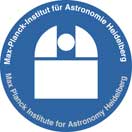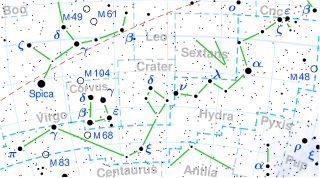
Hodge 301 is a star cluster in the Tarantula Nebula, visible from Earth's Southern Hemisphere. The cluster and nebula lie about 168,000 light years away, in one of the Milky Way's orbiting satellite galaxies, the Large Magellanic Cloud.
Wilhelm Gliese was a German astronomer who specialized in the study and cataloging of nearby stars.
Kappa Telescopii is a solitary, yellow-hued star in the southern constellation of Telescopium. With an apparent visual magnitude of +5.20, it is visible to the naked eye. Based upon an annual parallax shift of 12.00 mas as seen from Earth, it is located around 272 light years from the Sun.

The Max-Planck-Institut für Astronomie is a research institute of the Max Planck Society (MPG). It is located in Heidelberg, Baden-Württemberg, Germany near the top of the Königstuhl, adjacent to the historic Landessternwarte Heidelberg-Königstuhl astronomical observatory. The institute primarily conducts basic research in the natural sciences in the field of astronomy.

Iota Aquarii, Latinised from ι Aquarii, is the Bayer designation for a binary star system in the equatorial constellation of Aquarius. It is visible to the naked eye with an apparent magnitude of +4.279. Based upon parallax measurements made during the Hipparcos mission, the distance to this star is around 175 light-years. The system is drifting closer to the Sun with a radial velocity of −10 km/s.

Gamma Hydrae is a star in the equatorial constellation of Hydra. It has an apparent visual magnitude of 3.0, placing it second in brightness among the members of this generally faint constellation. Based upon parallax measurements made during the Hipparcos mission, this star is at a distance of around 133.8 light-years from Earth.

The Astronomical Calculation Institute is a research institute in Heidelberg, Germany, dating from the 1700s. Beginning in 2005, the ARI became part of the Center for Astronomy at Heidelberg University. Previously, the institute directly belonged to the state of Baden-Württemberg.

Astronomische Nachrichten, one of the first international journals in the field of astronomy, was established in 1821 by the German astronomer Heinrich Christian Schumacher. It claims to be the oldest astronomical journal in the world that is still being published. The publication today specializes in articles on solar physics, extragalactic astronomy, cosmology, geophysics, and instrumentation for these fields. All articles are subject to peer review.

Kenneth Charles Freeman is an Australian astronomer and astrophysicist who is currently Duffield Professor of Astronomy in the Research School of Astronomy and Astrophysics at the Mount Stromlo Observatory of the Australian National University in Canberra. He was born in Perth, Western Australia in 1940, studied mathematics and physics at the University of Western Australia, and graduated with first class honours in applied mathematics in 1962. He then went to Cambridge University for postgraduate work in theoretical astrophysics with Leon Mestel and Donald Lynden-Bell, and completed his doctorate in 1965. Following a postdoctoral appointment at the University of Texas with Gérard de Vaucouleurs, and a research fellowship at Trinity College, Cambridge, he returned to Australia in 1967 as a Queen Elizabeth Fellow at Mount Stromlo. Apart from a year in the Kapteyn Institute in Groningen in 1976 and some occasional absences overseas, he has been at Mount Stromlo ever since.

Gamma Piscium is a star approximately 138 light years away from Earth, in the zodiac constellation of Pisces. It is a yellow star with a spectral type of G8 III, meaning it has a surface temperature of 4,833 K and is a giant star. It is slightly cooler than the Sun, yet it is 11 solar radii in size and shines with the light of 63 Suns. At an apparent magnitude of 3.7, it is the second brightest star in the constellation Pisces, between Eta and Alpha. Once a white A2 star, it is 5.5 billion years old.

The Astronomische Gesellschaft is an astronomical society established in 1863 in Heidelberg, the second oldest astronomical society after the Royal Astronomical Society.

Reinhard Genzel is a German astrophysicist, co-director of the Max Planck Institute for Extraterrestrial Physics, a professor at LMU and an emeritus professor at the University of California, Berkeley. He was awarded the 2020 Nobel Prize in Physics "for the discovery of a supermassive compact object at the centre of our galaxy", which he shared with Andrea Ghez and Roger Penrose. In a 2021 interview given to Federal University of Pará in Brazil, Genzel recalls his journey as a physicist; the influence of his father, Ludwig Genzel; his experiences working with Charles H. Townes; and more.
Waltraut Seitter was a German astronomer and became the first woman in Germany to hold an astronomy chair.
The Faculty of Physics and Astronomy is one of twelve faculties at the University of Heidelberg. It comprises the Kirchhoff Institute of Physics, the Institute of Physics, Theoretical Physics, Environmental Physics and Theoretical Astrophysics.
The Berliner Astronomisches Jahrbuch is an astronomical ephemeris almanac and one of the longest publication series in astronomy. It was a compendium of ephemerides of all large Solar System bodies and of fundamental stars which define the celestial reference system.
Stellar density is the average number of stars within a unit volume. It is similar to the stellar mass density, which is the total solar masses (MSun) found within a unit volume. Typically, the volume used by astronomers to describe the stellar density is a cubic parsec (pc3).

Kappa Cygni, Latinized from κ Cygni, is a star in the northern constellation of Cygnus. It has an apparent visual magnitude of 3.8, which is bright enough to be seen with the naked eye. In the constellation, it forms the tip of Cygnus's left wing. The radiant of the minor Kappa Cygnids meteor shower is located about 5° north of this star.

Stellar archaeology is the study of the early history of the universe, based on its early composition. By examining the chemical abundances of the earliest stars in the universe: metal-poor, Population II stars; insights are gained into their earlier, metal-free, Population III progenitors. This sheds light on such processes as galaxy formation and evolution, early star formation, nucleosynthesis in stars and supernovae, and the formation processes of the galactic halo. The field has already discovered that the Milky Way cannibalizes surrounding dwarf galaxies, giving it a youthful appearance.
Roberta M. Humphreys is an American observational stellar astrophysicist. She is Professor Emerita at the University of Minnesota. Her work has included Galactic structure, observational stellar evolution, stellar populations, and large databases. She is best known for her research on massive stars in the Milky Way and in nearby resolved galaxies.
Maryam Modjaz is a German-American astrophysicist who is a professor and Director of Equity and Inclusion at the New York University. Her research considers the death of massive stars. She was awarded an Alexander von Humboldt Foundation Fellowship in 2018, which she spent at the Max Planck Institute for Astronomy.












